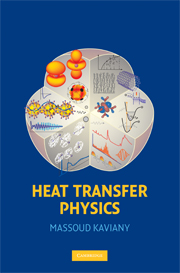Book contents
- Frontmatter
- Contents
- Preface
- Acknowledgments
- 1 Introduction and Preliminaries
- 2 Molecular Orbitals/Potentials/Dynamics, and Quantum Energy States
- 3 Carrier Energy Transport and Transformation Theories
- 4 Phonon Energy Storage, Transport and Transformation Kinetics
- 5 Electron Energy Storage, Transport and Transformation Kinetics
- 6 Fluid Particle Energy Storage, Transport and Transformation Kinetics
- 7 Photon Energy Storage, Transport and Transformation Kinetics
- APPENDIX A Tables of Properties and Universal Constants
- APPENDIX B Derivation of Green–Kubo Relation
- APPENDIX C Derivation of Minimum Phonon Conductivity Relations
- APPENDIX D Derivation of Phonon Boundary Resistance
- APPENDIX E Derivation of Fermi Golden Rule
- APPENDIX F Derivation of Equilibrium, Particle Probability Distribution Functions
- Nomenclature
- Abbreviations
- Glossary
- Bibliography
- Index
APPENDIX C - Derivation of Minimum Phonon Conductivity Relations
Published online by Cambridge University Press: 06 July 2010
- Frontmatter
- Contents
- Preface
- Acknowledgments
- 1 Introduction and Preliminaries
- 2 Molecular Orbitals/Potentials/Dynamics, and Quantum Energy States
- 3 Carrier Energy Transport and Transformation Theories
- 4 Phonon Energy Storage, Transport and Transformation Kinetics
- 5 Electron Energy Storage, Transport and Transformation Kinetics
- 6 Fluid Particle Energy Storage, Transport and Transformation Kinetics
- 7 Photon Energy Storage, Transport and Transformation Kinetics
- APPENDIX A Tables of Properties and Universal Constants
- APPENDIX B Derivation of Green–Kubo Relation
- APPENDIX C Derivation of Minimum Phonon Conductivity Relations
- APPENDIX D Derivation of Phonon Boundary Resistance
- APPENDIX E Derivation of Fermi Golden Rule
- APPENDIX F Derivation of Equilibrium, Particle Probability Distribution Functions
- Nomenclature
- Abbreviations
- Glossary
- Bibliography
- Index
Summary
Einstein Thermal Conductivity
The derivation presented in this section and the next is based on that given in [100, 52], with some of the mathematical steps given in more detail. The formulation of the Einstein thermal conductivity, kE, presented here is that given in [232], which is extended to arrive at the C-P high scatter limit, kCP, in Section C.2.
In the Einstein approach, the vibrational states do not correspond to phonons, but to the atoms themselves, which are assumed to be on a simple cubic lattice as shown in Figure C.1. As will be discussed, the choice of the crystal structure does not affect the final result. Each atom is treated as a set of three harmonic oscillators in mutually perpendicular directions. Although the atomic motions are taken to be independent, an atom is assumed to exchange energy with its first, second, and third nearest neighbors. The coupling is realized by modeling the atomic interactions as being a result of linear springs (with spring constant Γ) connecting the atoms. A given atom has 6 nearest neighbors at a distance of a, 12 second-nearest neighbors at a distance of 2½a, and 8 third-nearest neighbors at a distance of 3½a.
- Type
- Chapter
- Information
- Heat Transfer Physics , pp. 594 - 600Publisher: Cambridge University PressPrint publication year: 2008



